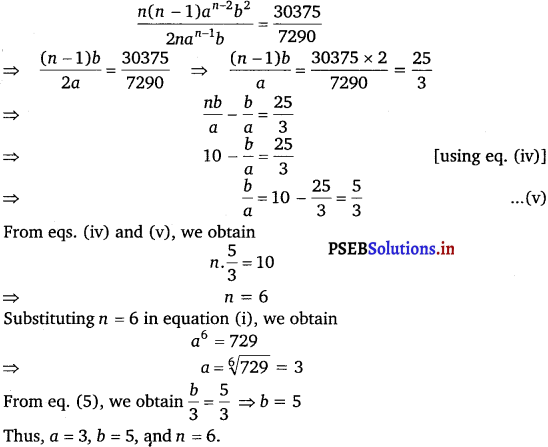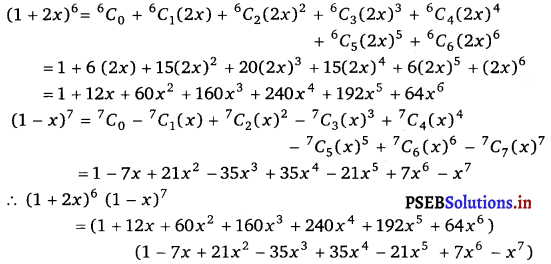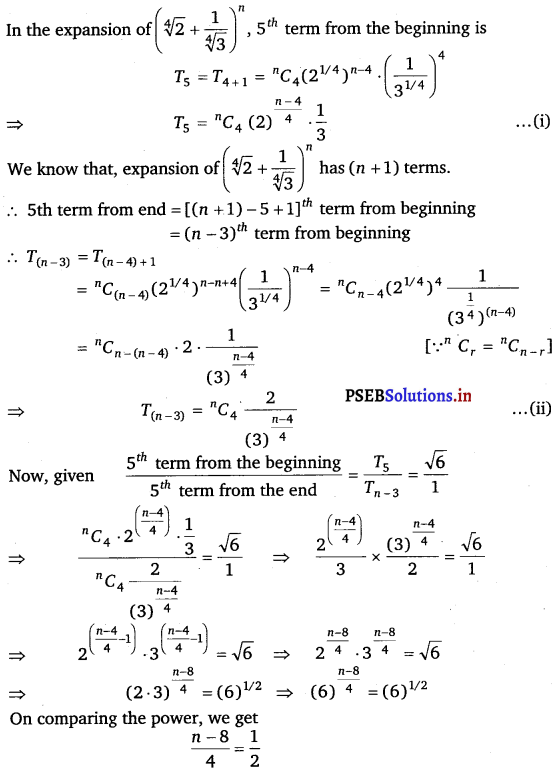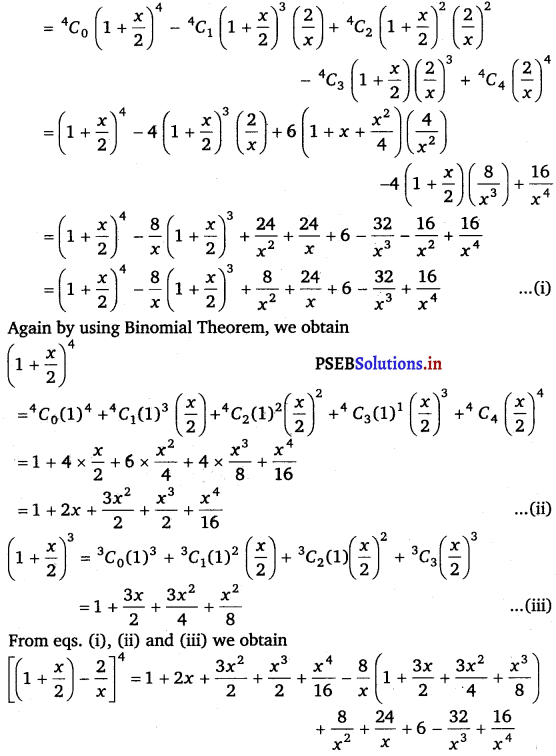Punjab State Board PSEB 11th Class Maths Book Solutions Chapter 8 Binomial Theorem Miscellaneous Exercise Questions and Answers.
PSEB Solutions for Class 11 Maths Chapter 8 Binomial Theorem Miscellaneous Exercise
Question 1.
Find a, b and n in the expansion of (a + b)n if the first three terms of the expansion are 729, 7290 and 30375, respectively.
Answer.
It is known that (r + 1)th term, (Tr + 1), in the binomial expansion of (a + b)n is given by Tr + 1 = \({ }^{n} C_{r}\) an – r r= a
The first three terms of the expansion are given as 729, 7290, and 30375 respectively.
Therefore, we obtain
T1 = \({ }^{2} C_{0} a^{n-0} b^{0}\)
= an = 729 ……………..(i)
T2 = \({ }^{n} C_{1} a^{n-1} b^{1}\)
= n an – 1 b = 7290 …………….(ii)
T3 = \({ }^{n} C_{2} a^{n-2} b^{2}\)
= \(\frac{n(n-1)}{2} a^{n-2} b^{2}\) = 30375 ……………….(iii)
Dividing eq. (ii) by eq. (i), we obtain \(\frac{n a^{n-1} b}{a^{n}}=\frac{7290}{729}\)
⇒ \(\frac{n b}{a}\) = 10 ……………….(iv)
Dividing eq. (iii) by eq. (ii), we obtain

![]()
Question 2.
Find a if the coefficient of x2 and x3 in the expansion of (3 + ax)9 are equal.
Answer.
It is known that (r + 1)th term, (Tr + 1), in the binomial expansion of (a + b)n is given by Tr + 1 = \({ }^{n} C_{r} a^{n-r} b^{r}\)
Assuming that x2 occurs in the (r + 1)th term in the expansion of (3 + ax)9, we obtain
Tr + 1 = \({ }^{9} C_{r}(3)^{9-r}(a x)^{r}\)
= \({ }^{9} C_{r}(3){ }^{9-r} a^{r} x^{r}\)
Comparing the indices of x in x2 and in Tr + 1 we obtain r = 2
Thus, the coefficient of x2 is
\({ }^{9} C_{2}(3)^{9-2} a^{2}=\frac{9 !}{2 ! 7 !}(3)^{7} a^{2}=36(3)^{7} a^{2}\)
Assuming that x3 occurs in the (k + 1)th term in the expansion of (3 + ax)9, we obtain
Tk + 1 = \({ }^{9} C_{k}(3)^{9-k}(a x)^{k}={ }^{9} C_{k}(3)^{9-k} a^{k} x^{k}\)
Comparing the indices of x in x3 in Tr + 1, we obtain k = 3
Thus, the coefficient of x3 is
\({ }^{9} C_{3}(3)^{9-3} a^{3}=\frac{9 !}{3 ! 6 !}(3)^{6} a^{3}=84(3)^{6} a^{3}\)
It is given that the coefficients of x2 and x3 are same.
84 (3)6 a3 = 36 (3)7 a2
⇒ 84a = 36 × 3
⇒ a = \(\frac{36 \times 3}{84}=\frac{108}{84}\)
⇒ a = \(\frac{9}{7}\)
Thus, the required value of a is \(\frac{9}{7}\).
![]()
Question 3.
Find the coefficient of x5 in the product (1 + 2x)6(1 – x)7 using binomial theorem.
Answer.
Using Binomial Theorem, the expressions, (1 + 2x)6 and (1 – x)7, can be expanded as

The complete multiplication of the two brackets is not required to be carried out.
Only those terms, which involve x5, are required.
The terms containing x5 are
1 (- 21x5) + (12x) (35x4) + (60x2) (- 35x3) + (160x3) (21x2) + (240x4) (- 7x) + (192 x5)(1)
= 171 x5
Thus, the coefficient of x5 in the given product.
= – 21 + 420 – 2100 + 3360 -1 680 +192 = 171.
![]()
Question 4.
If a and b are distinct integers, prove that a – b is a factor of an – bn, whenever n is a positive integer.
[Hint : write an = (a – b + b)n and expand]
Answer.
In order to prove that (a – b) is a factor of (an – bn), it has to be proved that
an – bn = k(a – b), where k is some natural number
It can be written that, a = a – b + b
∴ an = (a – b + b)n = [(a – b) + b]n
= \({ }^{n} C_{0}(a-b)^{n}+{ }^{n} C_{1}(a-b){ }^{n-1} b+\ldots+{ }^{n} C_{n-1}(a-b) b^{n-1}+{ }^{n} C_{n} b^{n}\)
= \((a-b)^{n}+{ }^{n} C_{1}(a-b)^{n-1} b+\ldots+{ }^{n} C_{n-1}(a-b) b^{n-1}+b^{n}\)
\(a^{n}-b^{n}=(a-b)\left[(a-b)^{n-1}+{ }^{n} C_{1}(a-b)^{n-2} b+\ldots+{ }^{n} C_{n-1} b^{n-1}\right]\)an – bn = k (a -b)
where k = \(\left[(a-b)^{n-1}+{ }^{n} C_{1}(a-b)^{n-2} b+\ldots+{ }^{n} C_{n-1} b^{n-1}\right]\) is a natural number
This shows that (a – b) is a factor of (an – bn), where n is a positive integer.
![]()
Question 5.
Evaluate (√3 + √2)6 – (√3 – √2)6.
Answer.
Firstly, the expression (a + b)6 – (a – b)6 is simplified by using Binomial Theorem.
This can be done as
(a + b)6 = \({ }^{6} C_{0}\) a6 + \({ }^{6} C_{1}\) a5 b + \({ }^{6} C_{2}\) a4 b2 + \({ }^{6} C_{3}\) a3b3 + \({ }^{6} C_{4}\) a2b4 + \({ }^{6} C_{5}\) ab5 + \({ }^{6} C_{6}\) b6
= a6 + 6 a5b + 15 a4b2 + 20 a3b3 + 15 a2b4 + 6 ab5 + b6 (a – b)6
= \({ }^{6} C_{0}\) a6 – \({ }^{6} C_{1}\) a5b + \({ }^{6} C_{2}\) a4b2 – \({ }^{6} C_{3}\) a3b3 + \({ }^{6} C_{4}\) a2b4 – \({ }^{6} C_{5}\) a1b5 + \({ }^{6} C_{6}\) b6
= a6 – 6 a5b + 15 a4b2 – 20 a3b3 + 15 a2b4 – 6ab5 + b6
.-. (a + b)6 – (a – b)6 = 2[6a5b + 20a3b3 + 6ab5]
Putting a = √3 and b = √2, we obtain (√3 + √2)6 – (√3 – √2)6
= 2[6(√3)5 (√2) + 20 (√3)3 (√2)3 + 6 (√3) (√2)5]
= 2[54 √6 +120 √6 + 24 √6]
= 2 × 198 √6 = 396√6.
![]()
Question 6.
Find the value of (a2 + \(\sqrt{a^{2}-1}\))4 + (a2 – \(\sqrt{a^{2}-1}\))4.
Answer.
Firstly, the expression (x + y)4 + (x – y)4 is simplified by using Binomial Theorem.
This can be done as
(x + y)4 = \({ }^{4} C_{0}\) x4 + \({ }^{4} C_{1}\) x3y + \({ }^{4} C_{2}\) x2y2 + \({ }^{4} C_{3}\) xy3 + \({ }^{4} C_{4}\) y4
= x4 + 4x3y + 6x2y2 + 4xy3 + y4
(x – y)4 = \({ }^{4} C_{0}\) x4 – \({ }^{4} C_{1}\) x3y + \({ }^{4} C_{2}\) x2y2 – \({ }^{4} C_{3}\) xy3 + \({ }^{4} C_{4}\) y4
= x4 – 4x3y + 6x2y2 – 4xy3 + y4
∴ (x + y)4 + (x – y)4 = 2(x4 + 6x2y2 + y4).
Putting x = a2 and y = \(\sqrt{a^{2}-1}\), we obtain
(a2 + \(\sqrt{a^{2}-1}\))4 + (a2 – \(\sqrt{a^{2}-1}\))4
= 2 [(a2)4 + 6(a2)2 (Ja2 -l)2 + \(\left(\sqrt{a^{2}-1}\right)\)4]
= 2 [a8 + 6a4 (a2 – 1) + (a2 – 1)2]
= 2 [a8 + 6a6 – 6a4 + a4 – 2a2 + 1]
= 2 [a8 + 6a6 – 5a4 – 2a2 + 1]
= 2a8 + 12a6 – 10a4 – 4a2 + 2.
![]()
Question 7.
Find an approximation of (0.99)5 using the first three terms of its expansion.
Answer.
We have, (0.99)5 = (1 – 0.01)5
= 1 – \({ }^{5} C_{1}\) × (0.01) + \({ }^{5} C_{2}\) × (0.01)2 – ……….
= 1 – 0.05 + 10 × 0.0001 – ………..
= 1.001 – 0.05 = 0.951.
Question 8.
Find n, if the ratio of the fifth term from the beginning to the fifth term from the end in the expression of \(\left(\sqrt[4]{2}+\frac{1}{\sqrt[4]{3}}\right)^{n}\) is √6 : 1.
Answer.

2n – 16 = 4
⇒ 2n = 20
⇒ n = \(\frac{20}{2}\)
⇒ n = 10.
![]()
Question 9.
Expand using Binomial Theorem \(\left(1+\frac{x}{2}-\frac{2}{x}\right)^{4}\), x ≠ 0.
Answer.
Using Binomial Theorem, the given expression \(\left(1+\frac{x}{2}-\frac{2}{x}\right)^{4}\) can be expanded as \(\left[\left(1+\frac{x}{2}\right)-\frac{2}{x}\right]^{4}\),

= \(1+2 x+\frac{3}{2} x^{2}+\frac{x^{3}}{2}+\frac{x^{4}}{16}-\frac{8}{x}-12-6 x\) – \(x^{2}+\frac{8}{x^{2}}+\frac{24}{x}+6-\frac{32}{x^{3}}+\frac{16}{x^{4}}\)
= \(\frac{16}{x}+\frac{8}{x^{2}}-\frac{32}{x^{3}}+\frac{16}{x^{4}}-4 x+\frac{x^{2}}{2}+\frac{x^{3}}{2}+\frac{x^{4}}{16}-5\).
![]()
Question 10.
Find the expansion of (3x2 – 2ax + 3a2)3 using binomial theorem.
Answer.
Using Binomial Theorem, the given expression (3x2 – 2ax + 3a2)3 can be expanded as [(3x2 – 2ax) + 3a2]3
= \({ }^{3} C_{0}\) (3x2 – 2ax)3 + \({ }^{3} C_{1}\) (3x2 – 2ax)2 (3a2) + \({ }^{3} C_{2}\) (3x2 – 2ax) (3a2)2 + \({ }^{3} C_{3}\) (3a2)3
= (3x2 – 2ax)3 + 3 (9x4 – 12ax3 + 4a2x2) (3a2) + 3 (3x2 – 2ax) (9a4) + 27a6
= (3x2 – 2ax)3 + 81a2x4 – 108a3x3 + 36a4x2 + 81a4x2 – 54a5x + 27a6
= (3x2 -2ax)3 + 81 a2x4 – 108a3x3 + 117a4x2 – 54a5x + 27a6 …………….(i)
Again by using Binomial Theorem, we obtain (3x2 – 2ax)3
= \({ }^{3} C_{0}\) (3x2)3 – \({ }^{3} C_{1}\) (3x2)2 (2ax) + \({ }^{3} C_{2}\) (3x2) (2ax)2 – \({ }^{3} C_{3}\)(2ax)3
= 27x6 – 3(9x4) (2ax) + 3(3x2) (4a2x2) – 8a3x3
= 27x6 – 54ax5 + 36a2x4 – 8a3x3 ………….(ii)
From eqs. (i) and (ii), we obtain (3x2 – 2ax + 3a2)3
= 27x6 – 54ax5 + 36a2 x4 – 8a3x3 + 81a2x4 – 108a3x3 + 117a4x2 – 54a5x + 27a6
= 27x6 – 54ax5 + 117a2x4 – 116a3x3 + 117a4x2 – 54a5x + 27a6.
